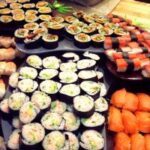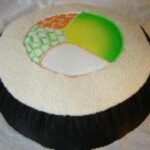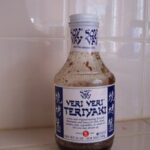Japanese restaurants in America don’t serve the traditional Japanese diet. I don’t think they even serve the traditional Japanese-American diet, or the Japanese immigrant diet. Growing up with my mom, from Japan, we rarely ate sushi, tempura, or teriyaki. We didn’t really eat Japanese more than two or three times a week, but when we did, it wasn’t often those foods.
We had a somewhat traditional Japanese diet. To be precise, it’s not really “traditional” as much as it was a diet frozen in time, from the mid 20th century, just before the island nation stopped cooking and started eating out of plastic pouches of instant food.
If you’re into the restaurant Japanese food, you might get into the “real” Japanese food. Unlike the restaurant food, you can eat the stuff below almost daily and it won’t wear you out with intense flavors or lots of grease. It’s pretty healthy, except for its excessive saltiness. Here’s a list of things that we ate:
Fish, mostly mackerels and tunas, prepared roasted or broiled, was common. The country is an island, and the preferred fish is the “fishy” mackerel called the Pacific saury or mackerel pike. It’s prepared “dry” so the flesh isn’t too moist, and takes on a stronger flavor. Also, sometimes, it’s cooked with the guts in; the guts turn bitter, and are considered a good flavoring. Sometimes, you’d luck out, and get a full egg sac full of cooked up roe.
Miso shiru, or miso broth. This is the broth they serve at the restaurant, with the tiny cubes of tofu. The homestyle kind we had usually had two or three large cubes of tofu, the size of ice cubes. The broth wasn’t clear, either, because there was more miso in there, as well as big slices of daikon (radish), onion, potato, cabbage, or carrots. Occasionally, there’d be an egg shirred into the broth. Basically, it was nothing like the broth at the restaurant.
Natto, or fermented soybeans, served on rice. The beans were mixed with onions and a raw egg, and flavored with Chinese mustard. This is an acquired taste, but if you like funky cheeses or heavy beers, you can learn to like natto.
Nimono or oden, which translates into cooked things. Oden is a bouilliabaise of fish cakes (described below) and vegetables simmered in dashi. Dashi is the Japanese broth that’s used to make miso shiru (above) as well as pretty much every other brown, Japanese tasting broth. Vegetables cooked up include sweet potato, daikon, carrots, gobo (burdock root), lotus root, bamboo shoots, yam cake (konnyaku), and a weird wheat dumpling thing that I can’t describe.
Fish cake, or kamaboko, is difficult to explain. It’s pollock, a white fish, ground up into a paste, that’s shaped into balls or logs, and steamed. It’s basically the same stuff as those fake Krab Legs. In oden, they use a kind that’s been fried to give it a nice brown color and texture, but it’s still fish cake. It’s something of an acquired taste, though even haters like me occasionally miss the flavor of it.
Tofu, of course, was eaten almost daily. It was usually served cold with chopped green onions and soy sauce. Other toppings included ginger and shaved bonito (katsuobushi). I personally like to add lemon to the onion.
We also ate okara, which is make from the soybean hulls left over after making tofu. It’s a mixture of the hulls, dashi, soy sauce, sugar, vegetables like carrots, bits of fried tofu (age), and other ingredients lightly cooked in a skillet.
Katsuobushi is dried, shaved bonito flakes. It’s one of the main flavors identified with Japan. It’s used to make dashi, or soup stock, that people are familiar with.
Rice was eaten daily. It was always white calrose, but these days, it’s brown calrose for health reasons. Interestingly, I think the brown now tastes really good.
Now, I have to digress a little bit. All the above foods are pretty healthy, but we didn’t have a healthy diet. While we didn’t have tempura more than but twice a month, we did have a lot of deep frying going on. Once the tempura oil was heated, we’d do things like make fried wontons or fried, beef-filled wontons. Eventually, we’d add french fries or tater tots, just because the oil was there, and hot. We’d also improvise tempura fritters to use up the remainder of the batter. A good use is to dump in a few chopped up green onions, and fry it up to make onion fritters. Now, back to the tradition.
Kombu is aged kelp – the aging gives it flavor. Nori is dried seaweed formed into paper-like sheets. Nori is used to make sushi rolls. A bit of both were eaten. Warning – kombu is an acquired taste.
We also ate a lot of musubi, or onigiri, which is rice balls. I know “onigiri” refers to those sushi with the fish on top, but, it also refers to round balls of rice filled with salted salmon or umeboshi, and wrapped in nori. The rice is plain, and there’s no vinegar in it like with sushi.
Umeboshi is a salted, pickled plum. It’s not actually a plum, but ume, a member of the apricot family. It’s extremely salty, and a little sour, and used as a food preservative as well as an ingredient. My mother actually made her own umeboshi.
Now, we did have sushi occasionally, but it’s a real pain in the ass to make, so we’d have chirashizushi, or “sideways sushi” as I’ve heard it called. It’s the sushi rice mixed with various ingredients like peas, eggs, fish, lotus root, gobo, and shiitake mushroom. Most people seem to prefer this “vulgar” style sushi more than the restaurant style.
By the way, sushi isn’t raw fish. It’s the vinegar flavored rice. The fish is “sashimi”, and the rice is “sushi”. The chirashi-zushi we ate didn’t contain any raw fish. We’d eat the raw fish by itself, as sashimi.
Teriyaki, we sometimes had, too, but usually we purchased it at church bazaars and fundraisers.
So, there you have it – a more “real” Japanese menu than you’d get at most restaurants. If you’ve read this far, you owe it to yourself to try and find an authentic Japanese dive, run by some Japanese folks, and start asking them to make traditional Japanese food for you.






